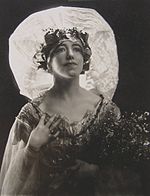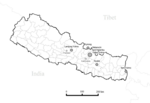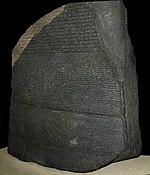WikiJournal of Humanities/Volume 2 Issue 1
Appearance
WikiJournal of Humanities
Open access • Publication charge free • Public peer review • Wikipedia-integrated
Journal issues
|
VOLUME 2 (2019)
ISSUE 1
Previous issue
Author: Hannah Holland
Hilda Rix Nicholas (née Rix, later Wright, 1 September 1884 – 3 August 1961) was an Australian artist. Born in the Victorian city of Ballarat, she studied under a leading Australian Impressionist, Frederick McCubbin, at the National Gallery of Victoria Art School from 1902 to 1905 and was an early member of the Melbourne Society of Women Painters and Sculptors. Following the death of her father in 1907, Rix, her only sibling Elsie and her mother travelled to Europe where she undertook further study, first in London and then Paris. Her teachers during the period included John Hassall, Richard Emil Miller and Théophile Steinlen. [...] After travelling to Tangier in 1912, Rix held several successful exhibitions of her work, with one drawing, Grande marche, Tanger, purchased by the French government. She was one of the first Australians to paint post-impressionist landscapes, was made a member of the Société des Peintres Orientalistes Français, and had works hung in the Paris Salon in 1911 and 1913. The family evacuated from France to England after the outbreak of World War I. A period of personal tragedy followed, as Rix's sister died in 1914, then her mother in 1915. In 1916 she met and married George Matson Nicholas, only to be widowed the next month when he was killed on the Western Front. Returning to Australia in 1918, Rix Nicholas once more took up professional painting, and held an exhibition of over a hundred works at Melbourne's Guild Hall. Many sold, including In Picardy, purchased by the National Gallery of Victoria. Following a period painting in rural locations in the early 1920s, Rix Nicholas returned to Europe. A 1925 exhibition in Paris led to the sale of her work In Australia to the Musée du Luxembourg, followed by an extensive tour of her paintings around regional British art galleries. Other exhibitions, such as the International Society of Sculptors, Painters and Gravers, and the Royal Academy of Arts, both in London, soon hosted her work. She was made an Associate of the Société Nationale des Beaux-Arts after several of her works were included in its 1926 Spring exhibition in Paris. In 1926, Rix Nicholas returned to Australia, and in 1928 she married Edgar Wright, whom she had met during her travels in the early 1920s. The couple settled at Delegate, New South Wales; their only child, a son named Rix Wright, was born in 1930. Though she continued to paint significant works including The Summer House and The Fair Musterer, Rix Nicholas, a staunch critic of modernism and disdainful of emerging major artists such as Russell Drysdale and William Dobell, grew out of step with trends in Australian art. Her pictures followed a conservative modern style, portraying an Australian pastoral ideal, and reviews of her exhibitions grew more uneven. She held her last solo show in 1947. Rix Nicholas remained at Delegate until her death in 1961. Her works are held in most major Australian collections, including the Art Gallery of South Australia, Australian War Memorial, National Gallery of Australia, National Gallery of Victoria, and the Queensland Art Gallery. doi: 10.15347/WJH/2019.004
Author: Christine Meyer
The themes encompassed in African-American writer Maya Angelou's seven autobiographies include racism, identity, family, and travel. Angelou (1928–2014) is best known for her first autobiography, the critically acclaimed I Know Why the Caged Bird Sings (1969). The rest of the books in her series are Gather Together in My Name (1974), Singin' and Swingin' and Gettin' Merry Like Christmas (1976), The Heart of a Woman (1981), All God's Children Need Traveling Shoes (1986), A Song Flung Up to Heaven (2002), and Mom & Me & Mom (2013). [...] Beginning with Caged Bird and ending with her final autobiography, Angelou uses the metaphor of a bird (which represents the confinement of racism and depression) struggling to escape its cage, as described in the Paul Laurence Dunbar poem "Sympathy". Angelou's autobiographies can be placed in the African-American literature tradition of political protest. Their unity underscores one of Angelou's central themes: the injustice of racism and how to fight it. According to scholar Pierre A. Walker, all of Angelou's books describe "a sequence of lessons about resisting racist oppression". In the course of her autobiographies, her views about Black-white relationships changed and she learned to accept different points of view. Angelou's theme of identity was established from the beginning of her autobiographies, with the opening lines in Caged Bird, and like other female writers in the late 1960s and early 1970s, she used the autobiography to reimagine ways of writing about women's lives and identities in a male-dominated society. Her original goal was to write about the lives of Black women in America, but it evolved in her later volumes to document the ups and downs of her own personal and professional life. The theme of family and family relationships—from the character-defining experience of Angelou's parents' abandonment in Caged Bird to her relationships with her son, husbands, friends, and lovers—are important in all of her books. As in American autobiography generally and in African-American autobiography specifically, which has its roots in the slave narrative, travel is another important theme in Angelou's autobiographies. Scholar Yolanda M. Manora called the travel motif in Angelou's autobiographies, beginning in Caged Bird, "a central metaphor for a psychic mobility". Angelou's autobiographies "stretch time and place", from Arkansas to Africa and back to the US, and span almost forty years, beginning from the start of World War II to the assassination of Martin Luther King, Jr. doi: 10.15347/WJH/2019.003
Author: Lauren Gawne
Yolmo is a Tibeto-Burman language spoken in Nepal. Also known as Helambu Sherpa, it is a Tibetic language. This article gives an overview of the language, including information about the dialects spoken, history of documentation, and a grammatical overview. The grammatical overview brings together work on different dialects, providing an outline of the sound system, noun phrase, verb phrase and clause structure.
doi: 10.15347/WJH/2019.002
Author: Andrew Dalby
The Rosetta Stone (British Museum EA24) is a granodiorite stele, found in 1799, inscribed with three versions of a decree issued at Memphis in 196 BC during the Ptolemaic dynasty on behalf of King Ptolemy V. The top and middle texts are in Ancient Egyptian using hieroglyphic and demotic scripts, respectively, while the bottom is in Ancient Greek. As the decree has only minor differences between the three versions, the Rosetta Stone proved to be the key to deciphering Egyptian hieroglyphs. [...] The stone, carved in black granodiorite during the Hellenistic period, is believed to have originally been displayed within a temple, possibly at nearby Sais. It was probably moved in Late Antiquity or during the Mameluk period, and was eventually used as building material in the construction of Fort Julien near the town of Rashid (Rosetta) in the Nile Delta. It was rediscovered there in July 1799 by a French soldier, Pierre-François Bouchard, during the Napoleonic campaign in Egypt. It was the first Ancient Egyptian bilingual text recovered in modern times, and it aroused widespread public interest with its potential to decipher this previously untranslated hieroglyphic script. Lithographic copies and plaster casts began circulating among European museums and scholars. Meanwhile, British troops defeated the French in Egypt in 1801, and the original stone came into British possession under the Capitulation of Alexandria and was transported to London. It has been on public display at the British Museum almost continuously since 1802, and is the most-visited object there. Study of the decree was already under way when the first full translation of the Greek text appeared in 1803. It was 20 years, however, before the transliteration of the Egyptian scripts was announced by Jean-François Champollion in Paris in 1822; it took longer still before scholars were able to read Ancient Egyptian inscriptions and literature confidently. Major advances in the decoding were recognition that the stone offered three versions of the same text (1799); that the demotic text used phonetic characters to spell foreign names (1802); that the hieroglyphic text did so as well, and had pervasive similarities to the demotic (Thomas Young, 1814); and that, in addition to being used for foreign names, phonetic characters were also used to spell native Egyptian words (Champollion, 1822–1824). Ever since its rediscovery, the stone has been the focus of nationalist rivalries, including its transfer from French to British possession during the Napoleonic Wars, a long-running dispute over the relative value of Young and Champollion's contributions to the decipherment, and demands for the stone's return to Egypt. Three other fragmentary copies of the same decree were discovered later, and several similar Egyptian bilingual or trilingual inscriptions are now known, including three slightly earlier Ptolemaic decrees (the Decree of Alexandria in 243 BC, the Decree of Canopus in 238 BC, and the Memphis decree of Ptolemy IV, c. 218 BC). The Rosetta Stone is, therefore, no longer unique, but it was the essential key to modern understanding of Ancient Egyptian literature and civilisation. The term Rosetta Stone is now used in other contexts as the name for the essential clue to a new field of knowledge. doi: 10.15347/WJH/2019.001
|

WikiJournal of Humanities
www.WikiJHum.org On social media
|






